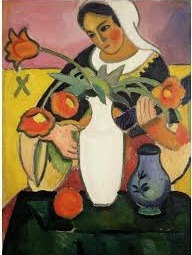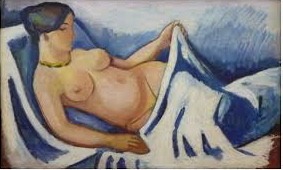“Recent publications” is in quotes because all of the great opportunities to preach the gospel of Marc lately have come to me strictly through the generosity of other people, so I will quickly get to the point of thanking Trang Vu Thuy and the curatorial staff at the Lenbachhaus and Janine Arnold of Notes About Art. (Please click through the links to view the articles themselves.)
My post (which is present entirely owing to the patience of Vu Thuy) “Ein Manifest der Freundschaft” is in honor of the August Macke und Franz Marc: Eine Künstlerfreundschaft exhibition (on through 3 May 2015 in the Lenbachhaus Kunstbau) and concerns one of my favorite subjects, the Paradies mural.
“Von »Köstlichen Figürchen« und »Wunderherlichen Farben«” by assistant curator Monika Bayer-Wermuth is actually the most wonderful post, though, on the gifts sent by the Marcs to the Mackes and is told in the same thoughtful, personal vein as are many of the chapters in the companion catalogue.
Thanks to the generous invitation of Arnold, I have two entries on her Notes About Art website, one called “Confrontations & Reconciliations” about my interpretation of Franz Marc’s gift of the painting Blaues Pferdchen, Kinderbild to August Macke and the other a bit about the history of Marc’s two Turm der blauen Pferde.
I am very happy to see art historians collaborating across distance and language just because we like the art and want for other people to be able to know about and appreciate the work of Der Blaue Reiter.
§ § §
So my linked posts do not get into the details of what was at the root of one of Marc’s and Macke’s hugest, and most-long running arguments, which is the painting by Macke you see above, Die Lauterspielerin. (I include here for comparison one of Macke’s many portraits of his wife, Elisabeth, Akt, Liegend from 1912.)
Macke was very convinced that Die Lautenspielerin was the pinnacle of his “complementary colors” experimentation phase, and pestered (and then demanded) that Marc include the painting in the two Blaue Reiter exhibitions as well as in the Almanac.
Marc declined to do so first for vague reasons of “space,” (which he quickly realized was totally a cop-out in light of the falling out with the NKVM over Kandinsky’s work), and then basically told Macke, quite gently, that he did not think Die Lautenspielerin would show Macke in a good light, that it was certainly not his best work. Well, August had a huge fit, and continued to be spitting mad, writing Marc several very angry letters over a period of months through 1911 and 1912.
I think Marc was in a position somewhere between telling a friend that their outfit is awful and they can’t wear it to the party :: telling your best friend that their S.O. is a jerk – what to do? Marc probably did the right thing. Die Lautenspielerin is too colorful, the woman figure overwrought. Often overlooked in discussions of Macke’s work over and against his great facility with color is his very confident and sensual handling of the human form. Macke didn’t like to use models, which is why Elisabeth, Helmuth Macke, and Franz also so often appear in his work, and to me the knowledge that we are looking at portraits derived from people and bodies August knew well gives these images an extra frisson. The Akt, Liegend portrait of Elisabeth Macke just as her second pregnancy is beginning to show is I think more representative of the pinnacle of Macke’s work, and the more restrained palette is a counterpoint of tonal elegance. What do you think?


 RSS - Posts
RSS - Posts